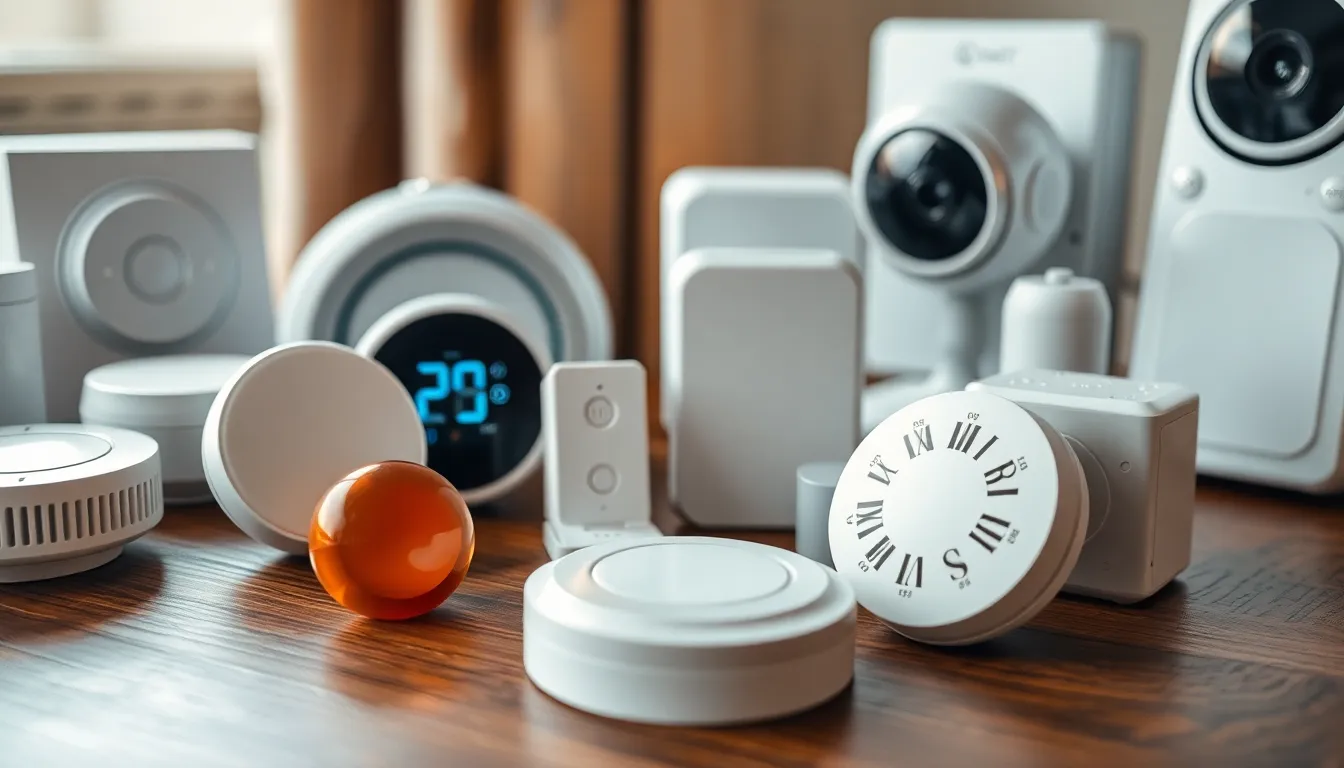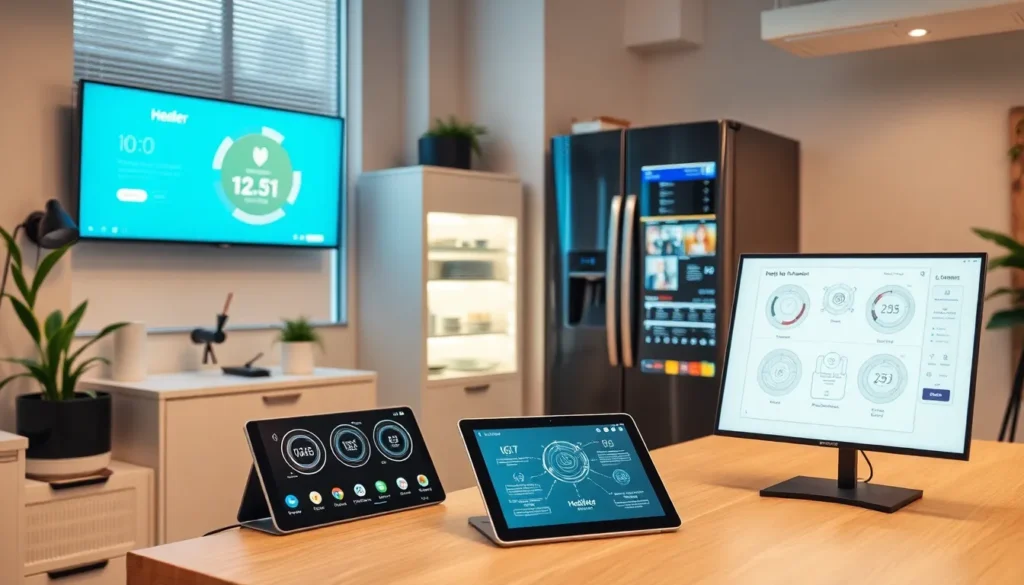Table of Contents
ToggleIn a world where your toaster might just be plotting against you, the Internet of Things (IoT) is revolutionizing how devices interact. IoT frameworks serve as the backbone of this technological uprising, connecting everything from smart fridges to wearable health monitors. They’re like the invisible glue that keeps our gadgets from staging a rebellion—ensuring they communicate effectively and operate seamlessly.
But let’s face it, diving into IoT frameworks can feel like trying to decipher ancient hieroglyphics while juggling flaming torches. Fear not! This article will break down the complexities of these frameworks, making them as easy to understand as your grandma’s secret cookie recipe. Get ready to explore how these frameworks are not just about connecting devices but also about transforming our daily lives in ways we never thought possible.
Overview of IoT Frameworks
IoT frameworks act as critical infrastructures that support the interaction among various connected devices. These frameworks streamline data exchange, ensuring that devices communicate efficiently and effectively. Developers rely on specific protocols and standard architectures that provide the foundation for application development and device management.
Multiple IoT frameworks exist, each offering unique features suitable for different use cases. For instance, MQTT is lightweight and particularly well-suited for low-bandwidth scenarios. Conversely, CoAP caters to constrained environments, allowing devices to communicate over the web.
Industry giants, including Google and Amazon, have developed their own IoT frameworks. Google Cloud IoT Core integrates seamlessly with Google services, providing robust data analysis and storage capabilities. Amazon Web Services IoT provides a scalable platform for device connection and management.
Common elements of IoT frameworks include device management, data processing, and security. Device management ensures that devices are correctly configured and maintained. Data processing involves analyzing the vast amount of information generated by IoT devices, leading to better decision-making. Security measures protect sensitive data and safeguard against potential breaches.
Interoperability stands out as a key advantage of IoT frameworks. Different devices and platforms can work together, enhancing the overall user experience. This connectivity opens avenues for innovative applications across various industries, such as healthcare, agriculture, and smart cities.
Understanding these frameworks unlocks the potential for creating smarter environments. Embracing IoT frameworks not only boosts efficiency but also drives emerging technologies forward, enabling transformative applications in everyday life.
Key Components of IoT Frameworks

IoT frameworks consist of critical elements that enable effective device interaction. They support various functionalities, ensuring seamless integration and data exchange among connected devices.
Sensor Integration
Sensor integration represents a foundational aspect of IoT frameworks. These sensors monitor environmental conditions, user behavior, and operational statuses. They gather real-time data, which plays a crucial role in decision-making processes. Manufacturers design sensors for specific applications, such as temperature sensors in smart thermostats and motion sensors in security systems. Data from these sensors can be utilized for automation and analytics, enhancing operational efficiency across different industries. For example, smart agriculture leverages soil moisture sensors to optimize irrigation practices. This integration allows systems to adjust dynamically based on incoming data.
Data Management
Data management encompasses various processes related to data collection, storage, and analysis within IoT frameworks. Efficient data management transforms raw data into actionable insights. Complex infrastructures often handle large volumes of data generated by numerous devices, requiring robust management strategies. Sorting, filtering, and processing data are vital for real-time analytics and historical insights. Many frameworks utilize cloud storage solutions to enhance scalability and accessibility. In many cases, effective data management enables businesses to identify trends, improve service delivery, and drive innovation. For instance, smart cities analyze traffic patterns to optimize public transport systems.
Communication Protocols
Communication protocols serve as the backbone of IoT frameworks, dictating how devices communicate and share data. Various protocols exist to accommodate different scenarios and device capabilities. Common protocols include MQTT, which is ideal for low-bandwidth environments, and HTTP, widely used in conventional web applications. CoAP is designed for constrained devices in smart environments. The selection of a communication protocol influences the efficiency and reliability of data exchange. Successful deployment of these protocols ensures that devices from different manufacturers can interact seamlessly. Effective communication protocols enhance overall user experience and foster interoperability across platforms and applications.
Popular IoT Frameworks
Various frameworks play a crucial role in shaping IoT ecosystems. Each framework offers unique features and benefits tailored to specific requirements.
Framework 1: Overview and Features
Google Cloud IoT Core stands out for its powerful data management capabilities. It allows users to connect, manage, and analyze devices through a unified platform. Built-in security features ensure data integrity and compliance. Scalability remains a key advantage, as organizations can smoothly adjust resources according to demand.
Framework 2: Overview and Features
Amazon Web Services IoT excels in its comprehensive device management. It supports multiple protocols, making it versatile for different connection types. Users appreciate its integration with machine learning services, which enhances data analytics. Real-time capabilities empower prompt decision-making, driving operational efficiency.
Framework 3: Overview and Features
Microsoft Azure IoT Suite emphasizes seamless integration with existing applications. This framework offers robust tools for device provisioning and monitoring. Security protocols within Azure ensure safe data exchanges between devices. Additionally, its easy-to-use interface simplifies adoption for businesses entering the IoT space.
Challenges in Implementing IoT Frameworks
Implementing IoT frameworks presents numerous challenges that affect performance and user experience.
Security Concerns
Security stands out as a primary issue in IoT frameworks. Various devices connect over the internet, increasing vulnerability to cyber threats. Protecting sensitive data demands robust encryption and authentication measures. As seen in numerous high-profile attacks, breaches can result in significant financial and reputational damage. IoT devices often lack consistent security features, making them easy targets. Developing standardized security protocols can enhance safety across devices. Ensuring updates and patches for all connected devices further strengthens security. Stakeholders must prioritize security to prevent potential exploitation in smart environments.
Scalability Issues
Scalability poses a significant challenge for IoT frameworks. Businesses aim to accommodate growth, yet many existing solutions struggle to keep pace with increasing device counts. High levels of data traffic may overwhelm systems, leading to latency and reduced performance. Frameworks must efficiently manage data influx to maintain operational efficiency. Adapting to changing requirements requires architectural flexibility for easier management. Investment in scalable solutions often proves essential for long-term success. Evaluating existing infrastructure can pinpoint limitations and guide improvements in scalability. Emphasizing growth potential facilitates smoother transitions as organizations adopt IoT technologies.
The evolution of IoT frameworks is reshaping how devices interact and enhancing everyday experiences. By streamlining communication and ensuring interoperability, these frameworks empower users and businesses alike to leverage the full potential of connected technology.
As industries continue to embrace IoT solutions, the focus on security and scalability remains crucial for sustainable growth. Investing in robust frameworks not only addresses current challenges but also paves the way for innovative applications across various sectors.
Understanding the nuances of IoT frameworks will ultimately drive smarter environments and improve operational efficiencies, making it an essential area of focus for anyone looking to navigate the future of technology.







